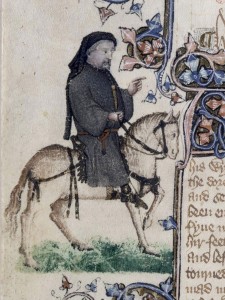Valentine’s Day hasn’t always been associated with love notes and heart-shaped candies. For hundreds of years, it was just a feast day honoring a Christian saint who was martyred in the 3rd century.
Then came medieval poet Geoffrey Chaucer, whose work about matchmaking birds that gathered on Feb. 14 changed everything.
That’s not all that changed about love in the Middle Ages, when authors described courtship as a game with specific rules and developed many of the ideas and expectations for romantic love that continue to this day.
Professor of English Rosemary O’Neill, who chairs the Department of Gender & Sexuality Studies, covers all this and more in her classes “Love, Sex and Desire in Medieval Romance” and “Premodern Sexualities.” As Valentine’s Day approaches, she took a few minutes to discuss the complex messages about love that are encoded in medieval literature and their lasting ramifications.
Is it true that Geoffrey Chaucer invented Valentine’s Day in one of his poems?
“The Parliament of Fowls,” yes! We think it was written in 1382, and it’s the first text that links Valentine’s Day specifically with courtship. The idea is the birds are called together on this day, the Feast of St. Valentine in February, and that’s when they all choose their mates. He’s poking fun at the idea of this rational approach to courtship and mating. The parliament is going to decide who this female eagle is going to marry, and she has three different suitors who all plead their case. Ultimately, what’s very interesting about the poem is that the female eagle declines to select one of the mates. She says, “Give me until next year to decide.”
How do medieval notions of romantic love compare to modern ones? What might surprise people today?
Fundamentally, our notions of love are medieval. Courtly love was invented in the Middle Ages. I think it might surprise us that it’s initially extramarital. “Marriage is no real excuse for not loving,” Andreas Capellanus says as the first rule of courtly love (in his 12th century work “The Art of Courtly Love”). So you would never be so vulgar as to love your actual spouse. That has to do with the courtly setting. These are really aristocratic people who are mostly in arranged marriages, sometimes with someone with a vast age gap.
How do students react to these rules today?
I always ask my students to do the “Kenyon Rules of Love” when they read Capellanus, and they talk about the need to keep relationships secret — away from gossip, away from prying eyes. He has descriptions of the physical effects of being in love — of kind of a fluttering heart and not eating and not sleeping — that I feel like continue to resonate with students today.
What else strikes a chord with students?
I think they’re attracted to the elements of courtly love that suggest that love is ennobling or that love is an issue of character. There’s one rule that good character alone makes any man worthy of love, and I think they feel like that should really be underlined. Another one that often resonates for them is the last one: Nothing forbids one woman being loved by two men, one man by two women. I think that continues to be a reality of love.
In what important ways are students’ conceptions of love different?
They will always bring up that you don’t have to be a man loving a woman or a woman loving a man. They have an expanded sense of gender possibilities and queer love.
Your classes read the oldest surviving valentine in the English language. Why?
One of the problems is figuring out the extent to which literary movements give us insight into what people actually thought or how they actually lived. On Valentine’s Day, I’m going to be teaching in my “Premodern Sexualities” class the Paston letters, which is this group of letters from 15th-century gentry women in Norwich (in England). What you see there is that in the 15th century, people are sending valentines to each other. So it takes off. Chaucer does this thing in 1382 in his poem, and then less than a hundred years later, people are saying, “Happy Valentine’s Day” or “Be My Valentine” in letters.
What’s that early valentine like?
It’s written from the woman to the man before they are married. It shows that they did have affectionate romantic love in this family. It begins, “Right reverend and worshipful and my right well-beloved Valentine …” Then she quotes a little bit of poetry. It’s part of their courtship.
Are there ways that love goes wrong in medieval stories?
Oh, definitely. All of them, basically. “The Canterbury Tales” is mostly about marriage and love and love affairs, and it’s usually terrible. Chaucer seems to be very interested in rape as a problem, so that’s one way that things go very, very wrong. There’s also these very unhappy marriages, usually between a much younger woman and a much older man. He seems very interested in that arrangement.
What’s the value of studying this all these years later?
For students, it just expands their perspective. It’s like meeting these fascinating new people who are sort of the same as us, but also profoundly different, and it expands their sense of what a human being can be to encounter both of those at the same time.
